If you’re looking for an ergonomic chair, that will best fit a wide range of users out of the box, the Steelcase Gesture is likely what you need. With our highest scope of users score at 91, our closest competitor scored seven points less and was a close family member, the Steelcase Leap chair. Of course, this doesn’t come without a cost. At $1,348+, the Steelcase Gesture is one of the most expensive chairs we tested overall and the most expensive Steelcase office chair tested. Let’s take a closer look to find out if it was worth the price tag.
Full Disclaimer: We are an office furniture dealer and sell some of the products we review. To learn more about the products we sell, our review process and why you can trust us, please visit: Why we’re different. Who is BTOD.com and The Breakroom Blog?
Manufacturer
Steelcase was established in 1912 as the Metal Office Furniture company. Its first patent as a company was for a metal wastebasket, which was designed to improve office safety. Back in the early 1900s, wicker was used for baskets creating a fire hazard for crowded cities.
As early as 1919, it began to form dealer networks and offering its office furniture products across the USA. In 1954, its name changed to Steelcase Inc. and its brand continued to grow. By 1998, Steelcase Inc. became a publicly traded company.
Steelcase Gesture Chair Review Links
– Specs / Features / Pricing
– Return Policy and Warranty
– Shipping and Assembly
– Build Quality
– Scope of Users
– Seat Comfort
– Back Support
– Armrest Comfort
– Ergonomics Adjustments
– Upholstery Options
– Mechanism Options
– Wheel/Caster Options
– Environmental
– What I Like
– What I Don’t Like
Steelcase Gesture History
The development of the Steelcase Gesture was as unique as the chair itself, starting first with studying the human body, before the chair design itself. Steelcase wanted a product that was able to support the user, regardless of the device they were using.
To get a better understanding of a user’s posture, they studied over 2,000 people from around the globe. Through this research, they found that new technology created nine additional postures. These new postures were not being addressed by the current seating available, so the Gesture Chair was created.
Country of Origin
Made in Mexico
Specs
Seat Height: 16” – 20.5”
Seat Depth: 15.75” – 18.75” D
Seat Width: 19.25”
Arm Height: 7.25” – 11.5”
Arm Width: 10.25” – 22.5”
Back Height/Width: 24.0625” H / 16.25” W
Overall: 24.75” D x 27” W x 38.5” – 43.5” H
Weight Rating: 400 lbs.
Gesture Features
Seat height adjustment
Seat depth adjustment
4D arms with a massive adjustment range
Three position tilt lock
Adjustable lumbar support (optional)
Flexible backrest that moves with you
400 lbs. weight capacity
Steelcase Gesture 2025 Starting Price – $1,444.00 Where To Buy: Steelcase.com
There is a bit of customization available with the Steelcase Gesture. The most basic version of the chair will cost $1,348.00. This setup will include the standard shell back, Buzz2 upholstery, Black/Black or Dark/Dark frame, no arms, matching base (frame color), carpet casters and no additional lumbar support. The available upgrades are below. For more details on the upholstery options see the “Upholstery Options” section.
Return Policy
All Steelcase chairs come with a 30-day money back guarantee. This includes free return shipping and no restocking fees. The chair must be returned in new condition in the original packaging to receive the full refund.
Warranty
The Steelcase Gesture includes one of the best warranties in the business. The frame of the chair is covered for the lifetime of the original owner. The mechanisms, gas cylinders, arms, foam padding, and casters are covered for a period of 12 years. This warranty is good regardless of the shift usage, which means the chair is rated for 24/7 usage.
Steelcase will repair or replace your chair with a comparable product, at its option and free of charge (for materials and components) for any product, part or component which fails under normal use. If repair or replacement is not commercially practicable, Steelcase will provide a refund or credit for the affected product.
*Bo Peep, Brisa, Cogent: Geode Seating, Cogent: Geode Vertical; CuraNet™; Gaja-Cradle to CradleCM, Jacks, Link™, Nitelights, Redeem, Remix, Retrieve; Sprite, Spyder, Steelcut Trio, and Zoe2 are covered for a period of five years.
Shipping
When ordered in small quantities, the Steelcase Gesture chair can be shipped via FedEx Ground. Our chair came in a very large box, with handles, and weighed approximately 70 lbs. Because of the size of the package, you may want an extra set of hands to move the box in the office.
Inside the box, the chair is put into a plastic bag to keep it clean and reduce the opportunity for surface scratching. There is a large cardboard piece, included with a bag of air, to hold the chair in place. The box is designed to hold the leap and is perfectly sized to reduce any movement while in transit. Overall, the chair was very well packed and should arrive in perfect condition.
Assembly
One of the things that we really like about the Steelcase Gesture chair is the fact it ships fully assembled. The only thing you’re required to do is remove the chair from the box and pull away from the minimal packaging. If you’re at all concerned with assembly, this is one of the best products in the category with no assembly required.
Build Quality
With a score of 88 out of 100, the Gesture chair ranked fourth out of all chairs tested. Those same top five chairs sell for $1000 or more, making it clear you must pay top dollar for premium quality. That was the case with the Gesture, as the only chair to outrank it was the iconic Aeron chair, scoring a 95.
The Steelcase Gesture chair was one of the most well put together chairs that we tested. From the bottom of the chair to the top of the backrest, there was a high level of quality and consistency throughout.
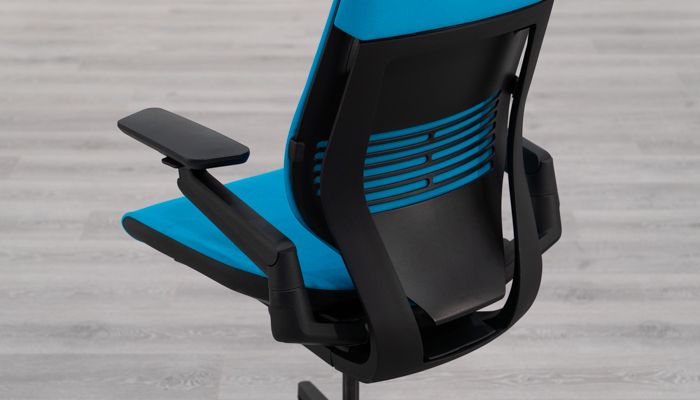
Much like the Steelcase Leap chair, the Gesture used quite of a few plastic components on the chair. Don’t let this fool you though, the chair was still solid and well built. Most of the plastic components were either used for flexibility in the chair back or to cover metal components. One thing we always look for with plastic components is how well they are finished and if they fit together properly. In both areas, the Gesture did extremely well.
The reason the Steelcase Gesture scored an additional point over the Leap was how they finished the bottom of the seat. Specifically, how they used custom molded plastic to cover the metal mechanism components. This created a cleaner look than what we found on the Leap chair.
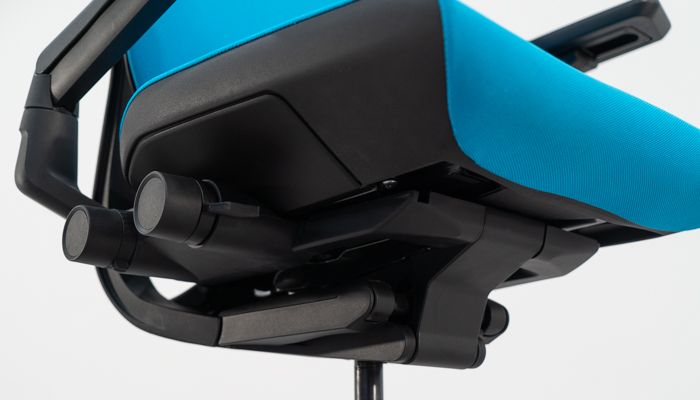
Scope of Users
If you’re looking for a single chair that is adjustable enough to fit most users, this Gesture is by far the best we’ve tested. The seat height adjustment on the Gesture is standard at 16” to 21”, fitting the 5th to 95th percentile without any issues. Pair that with a seat slider for shorter and longer legs, and you shouldn’t have issues getting a comfortable seated position with the Gesture.
Their secret to maximizing the user score is in the arms. While a lot of arms in the list include 4-way adjustment, none offered the range of motion found on the Gesture. There is so much flexibility with the arms that all typing/working positions should be supported properly.
Seat Comfort
Because seat comfort is such a subjective thing, we always make sure to take an average of the nine people in our office. Each was given the opportunity to sit in the Gesture for an extended period before scoring the seat comfort. When all was said and done, it received an 81 out of 100, which put it squarely in the top five for another important category.
This is just another example of how strong of a chair the Gesture is. With a score of 81 for the seat comfort, there is a good chance most would find this chair comfortable to sit in. Much like the Leap chair, there wasn’t a significant amount of padding. While it didn’t score as high as the Leap, it had a similar feel it.
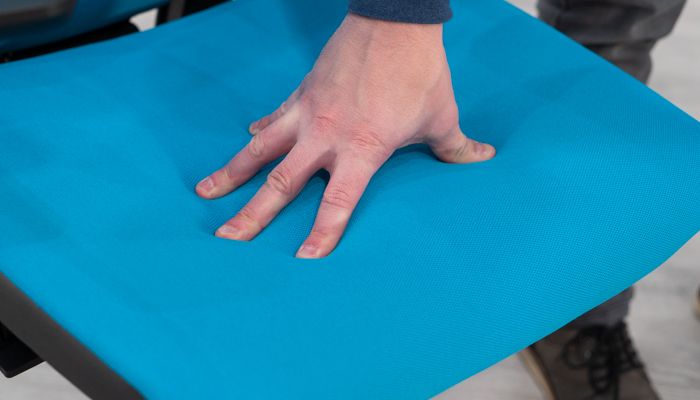
Not having a thick padded seat might be a turn off some users, but at the end of the day, it should be about good support. The Steelcase Gesture chairs padded seat is less than 2” thick, but still provides excellent support for 8+ hours sitting a day. I’ve personally sat in the chair for about three weeks and had no issues with pressure points over long periods of sitting.
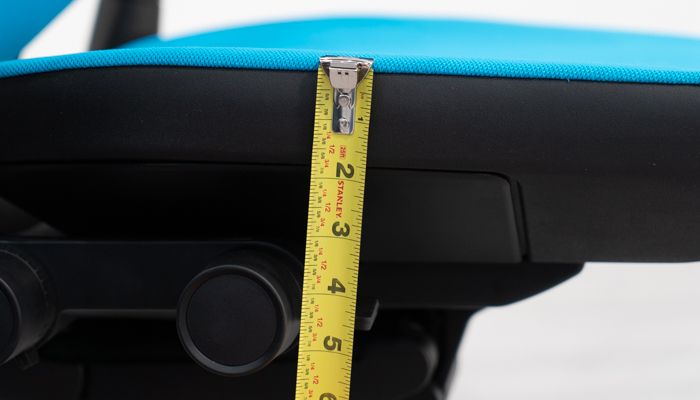
Back Support
The backrest support score is the second area we used the office average to come up with a more accurate score. How comfortable a backrest can depend on where support is needed and how much. With that said, the Gesture scored 80 out of 100, putting it in the top six overall.
One of the first things that I noticed about the Gesture was that the adjustable lumbar didn’t seem very pronounced. This can be a good or bad thing, depending on how supportive it feels to you. While you could feel the lumbar system, it wasn’t as much as the Steelcase Leap.
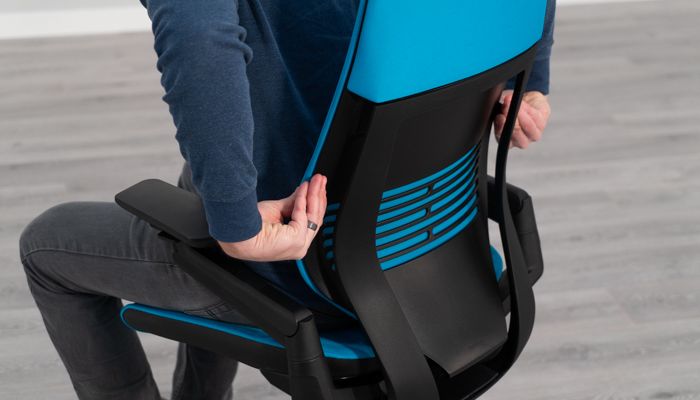
The back did provide good support. The backrest is tall, and as someone that stands at six feet, when I lean back into the chair I had good support through the upper portion of my back. There weren’t any awkward pressure points or areas that were uncomfortable. If you’re taller than 6’4”, you may notice the upper portion of the backrest hitting your shoulders.
I found the way that the backrest moved to be interesting. When locked in the upright position, there was still a bit of movement. If you’re looking for a chair that locks into a perfectly upright position, the Gesture will not do that. If you find yourself moving more, the backrest is nice and provides a unique flexing from the mid to upper portion of the backrest.
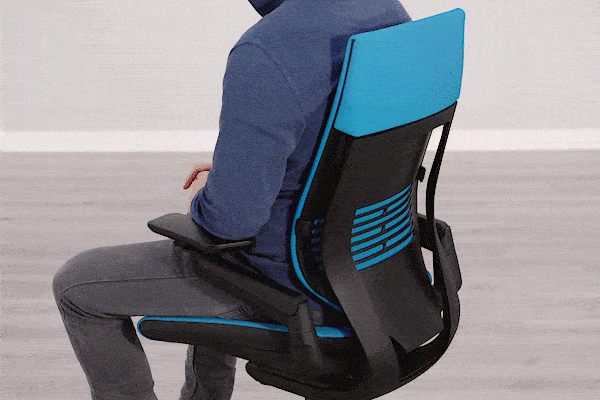
Armrest Comfort
Armrest comfort is a lot like seat comfort, it tends to be subjective and vary depending on the user. Because of this, it was the last of three scores that used the average of nine users. The Gesture chair was one of the strongest performers, with an 84 out of 100, it was only out ranked by the Steelcase Leap v2.
When scoring, we looked at two different aspects of the armrests: how comfortable they were for the user’s elbows and forearms and if they were able to be adjusted to fit properly. Meaning, could you get into a comfortable ergonomic position with the arms?
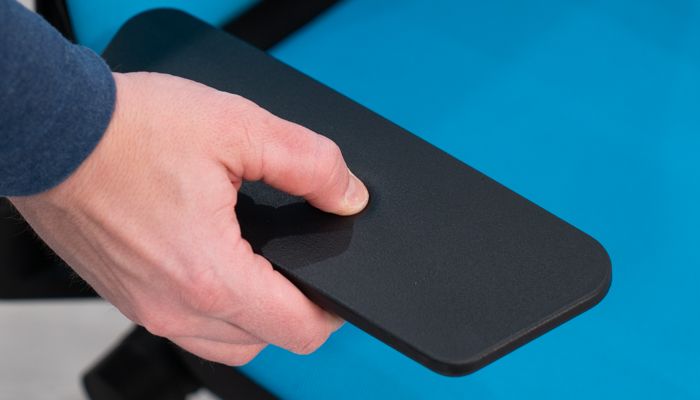
The Gesture comes standard with 4-way adjustable arms that are different than any we’ve seen previously. The Gesture’s arms provide common adjustments including height, width, depth, and pivot. The real difference is how widely adjustable they are. There is a staggering 10.25” of width adjustment, providing support from 10.25” to 22.5” wide (inside). Pairing this with 4.25” of height adjustment and the depth/pivot functions, the Gesture can provide arm/shoulder support like no other chair we’ve tested.

Ergonomic Adjustments
When we score the ergonomic adjustments on office chairs, we score solely on if the chair has the adjustment. So, if a chair has seat height adjustment, it would get the full number of points available. The only exception is tilt lock, where we scored based on the number of positions the chair would lock. The Steelcase Gesture chair was our number one ranked chair for adjustments, with a score of 90 out of 100.
With almost every adjustment box checked, the Steelcase Gesture qualifies as a loaded ergonomic chair. Only back height adjustment was missing from the Gesture. Like the Steelcase Leap, the way the back was tied into the seat was likely the reason for this. Steelcase wanted to create a unique movement as you reclined back in the chair, without losing the flex in the backrest. All these things must work in harmony, so it’s a fair tradeoff.
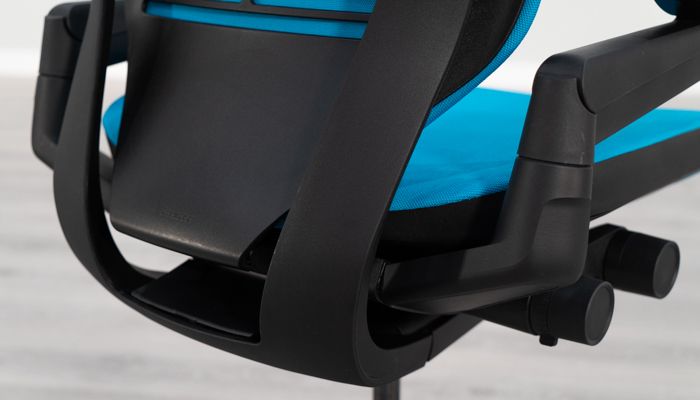
One of my favorite adjustments on the Steelcase Gesture is the seat slider function. With most office chairs, making this adjustment can be awkward. The process is generally the same, use a lever, lift your body weight and slide the seat back and forth (with some weight still applied to the seat). The Gesture has a knob that you can easily turn to adjust the seat pan for shorter or longer legs.
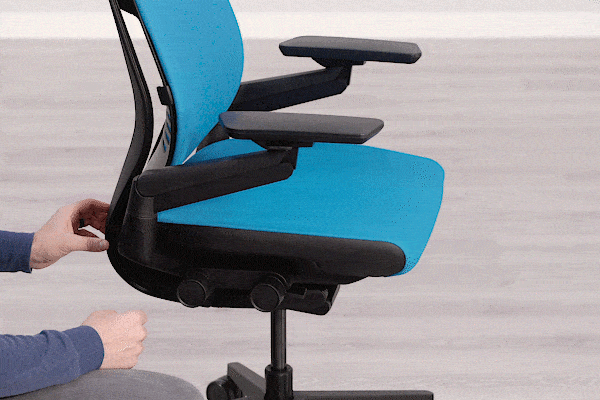
Upholstery Options
The Steelcase Gesture comes with a wide selection of standard upholsteries. If you’re looking for a chair to ship quickly, the Buzz2, Cogent, Remix and Leather upholsteries ship in 4-5 business days. The Steelcase also offers the Billiard and Bo Peep selection of upholstery, but they extend the lead time out to 28 business days.
Mechanism Options
The Steelcase Gesture mechanism comes fully loaded from the factory. Cutting down on mechanism options can simplify the order process and ensure a consistent experience.
We really liked the mechanism on the Gesture. Internally the mechanism was well built and heavy. It was made for the Gesture, meaning the design was made specifically for this model. The fit and finish was well done, with custom plastic covers to complete the underside of the chair. The overall design was slim and didn’t take away from the underside of the chair, doing a good job of blending in.
Cylinder Options
The Gesture was available in two different cylinder options. The standard cylinder was selected for our chair, providing 16-21” of height adjustment. This is perfect for most user’s task chair needs. Steelcase also provides an extended version with footring that is designed as a drafting stool. The stool option will provide 24” to 32.25” of height adjustment.
Wheel/Caster Options
There are two options available for casters on the Gesture. The standard is a carpet caster, made for low pile carpet. Our chair came with the wheels designed for a hard surface. They include a polyurethane material on the wheel to protect the floors.
Environmental
The Steelcase Gesture chair was designed for sustainability. With up to 25% of each chair, by weight, using recycled content. Up to 85% of the chair is recyclable by weight as well. The Gesture chair is manufactured with powder coated paints, water-based adhesives, and VOC-free manufacturing processes.
The Gesture chair comes with multiple environmental certifications. This includes both level two and level three ANSI/BIFMA certifications. It also has the Gold Indoor Air Advantage Certified by SCS.
Steelcase’s focus to long term sustainability is shown with the attention to the life cycle of the product. The Gesture’s back cushions, seat assembly and arms can be updated and replaced at any time. This prevents the need to replace an entire chair when certain components need to be refreshed.
What I Like
High-End Build Quality
Second-ranked in the build quality category, only the Herman Miller Aeron beat it out of first place. Had the Gesture been manufactured in the USA, there is a chance it could have gotten closer to the Aeron.
Overall, the Gesture was well built. The fit and finish throughout the entire chair were well done. It didn’t appear as any portion of the chair was an afterthought. The slim design of the mechanism and custom plastic covers helped to put the focus on the actual chair. This was a nice touch, as some chairs have a large bulky mechanism that can take away some of the aesthetics of the chair.
Like the Steelcase Leap, the Gesture comes with a 400 lbs. weight capacity for a standard sized office chair. Considering the testing they’ve done on the chair, this speaks volumes of the confidence they have of their chair holding up to heavier users.
Fits Wide Range of Users
There isn’t another chair that we tested that could fit a wider range of users out of the box. The Gestures one-size fits most approach is a nice touch and makes it easier to share in a home office or multi-shift environment. If you’re trying to find consistency in the office, the Gesture could a great fit.
Most Adjustable Arms Tested
Designed with so many different types of posture in mind, Steelcase saw the value in creating widely adjustable arms. Even with the highly adjustable Leap arms already developed, they still pursued something even more adjustable. The fact they went above and beyond here shows a strong commitment to good ergonomics.
Intuitive Seat Slider Function
It’s hard to believe more companies aren’t looking to improve upon the seat slider function. One of the most awkward adjustments on an office chair, the butt sliding technique required for most chairs, can be an annoyance. The knob added to the Gesture makes this adjustment a breeze for anyone.
By simply rotating the knob in either direction will adjust the depth of the seat pan for shorter or longer legs. This ease of use ensures that people will take advantage of the functionality. One of the biggest issues we’ve found with highly adjustable ergonomic chairs is not actually using the adjustments. With something so easy, it almost guarantees use because the instant feedback you get from turning the knob.
Good Seat Comfort
Having reviewed both the Leap and Gesture, I have found an appreciation for their ability to create comfortable seats without thick padding. Even if you’re the type that likes a big thick seat pad, there is a good chance you’ll find good long-term comfort in the Gesture chair. While the Gesture didn’t score tops in the category, it was still in the top six for all chairs tested.
Excellent Warranty
Scoring 98 out of 100 for their warranty is nothing to scoff about. Steelcase carries one of the best warranties in the business for office seating. Considering the chair is rated for 400 lbs. and 24/7 usage, you can find comfort in the fact you should have a functioning chair for at least 12 years. While the investment is big up front, it is only $100 per year for one of the most comfortable chairs available.
Ships Fully Assembled
If you’re not big into assembly, or don’t have time for it, the Steelcase Gesture is likely a good fit. It is one of the few chairs we tested to come completely assembled. You just simply pull the chair from the box and it’s ready to be used.
What I Don’t Like
High Price Point
When a chair is approaching the $1000 mark, it becomes an easy target for people to consider it overpriced. The truth is that is a lot of money and pushes it out of quite a few office chair budgets. Because of this reason alone, we must list it as something we don’t like. While I feel the Steelcase Gesture is worth the high price tag, it doesn’t mean that it isn’t expensive.
No Back-Height Adjustment
There seems to be a reoccurring theme, Steelcase doesn’t appear to care much about height adjustable backrests. If this is something you want in a chair, the Gesture doesn’t come with the adjustment and I’d look elsewhere. We found the back to be comfortable and tall enough for most users. With every other adjustment included on the Gesture, you might be able to overlook this one.
Back Doesn’t Lock in Upright Position
Back positioning can be very important to some users, depending on their posture requirements. If you need a backrest that sits straight up and down, the Gesture could be a bad fit. We found during testing that the back moves slightly, even when locked in the upright position. While I liked this movement, it isn’t for everyone. To eliminate it, you can increase the recline tension. When you decide to actually recline in the chair you will need to loosen it again.
Made in Mexico
With only one chair ranking higher than the Gesture in build quality, the Herman Miller Aeron had it beat out by four points. The Gesture is a well-built chair, don’t get me wrong. There is something to be said for products being manufactured in the USA and had the Gesture been made here, it would have been closer to the Aeron.
Bottom Line
The bottom line is that the Steelcase Gesture is a solid chair. With the same score as the Leap chair, it is basically positioned in the 1-B spot for our best office chairs for 2024. I can see the value in both chairs and which one you like most will come down to personal preference on a few key areas.
If you’re on a tight budget, the Gesture is likely to be out of your price range. Starting at close to $1000, it is one of the most expensive chairs we tested. If you’re taller than 6’4”, the chair could potentially be on the small side for you. With a great return policy, you might not have to worry about trying before you buy though.
If you can afford the Gesture, I would put it at the top of the list for chairs to consider. Widely adjustable, there is a good chance it will fit most users well. The Gesture has a comfortable seat, back, and armrests; three of the most important aspects of creating a comfortable chair. When you break down the warranty, the Gesture is guaranteed to only cost you about $100 per year to own. If you consider how many cheap chairs you’ll buy in the same twelve-year period, then the Steelcase Gesture is suddenly a solid investment.
Additional Office Chair Resources
- Herman Miller Aeron Chair (Review / Rating / Pricing)
- Steelcase Leap v2 Ergonomic Office Chair (Review / Rating / Pricing)
- Humanscale Diffrient Smart Chair (Review / Rating / Pricing)
- 5 Reasons Ergonomic Chairs Will Improve Your Back Pain
- 6 Common Problems With Mesh Office Chairs
- 9 Most Common Problems With The Raynor Ergohuman Chair





Cody
I’ll never understand why this chair is rated so high. I purchased one in part, because of this and many other reviews. The build quality and looks, are top notch. Everything else, is mediocre at best.
Comfort? What comfort? You find yourself making various “gestures” (with your middle finger at times) to try and find a comfortable seating position after the first 30 minutes. The seat is horribly hard, and the backrest is nothing to write home about. The recline is just OK compared to the Herman Miller style recline on their high end chairs, and the armrests while very configurable, they certainly are not soft and comfortable. No real lumbar adjustability, even with the “added lumbar” upgrade which is 100% useless.
Overall this chair is no more comfortable than a well designed wooden kitchen chair. But the looks and arm rest design, ooohhh nice. Generally speaking though, looks should come far down the list after sitting comfort and adjustability.
I’m just shy of 6’0″ and I weigh 186lbs so well within good / “normal” proportions. I’m pretty sure this chair is the cause of my thigh and leg fatigue, and the stiff neck and shoulders I’ve had over the last week.
No go. Ergonomic is NOT an excuse for “rock hard”. As a matter of fact, there’s nothing ergonomic about these chairs that are stiff. They are the exact opposite of ergonomic; so I’m not sure why people excuse it in the name of “ergonomic” – it’s a straight up lie.
Cory
I’ve purchased two of these chairs — one with a headreset, the other without. After a few weeks, both developed a creaking noise in the area where the back meets the base. I can’t tell where it’s coming from without taking things apart. Very frustrating, since the chair is beautiful and very ergonomic, but even the cheapest of chairs don’t make this noise, let alone one of the most expensive. Extremely disappointing, and I don’t think this chair deserves such a high rating.
Jamie
If I were you, I would contact steelcase (888.783.3522) regarding the creaking noise. They may be able to resolve this issue.
I have read that using silicone grease is the best for stopping creaking noises.
Another Idea… but the link applies to the Steelcase leap….it may give you ideas on where to lube your chair: http://www.devonrosemusic.com/synthstuff/steelcaseleap.htm
–> I was curious, do you like your gesture chair with the headrest or without better?
Tony
Hey, how do you like the headrest? Is it too forward and gets in the way when you don’t want to rest your head? I’m interested in a headrest position where it’s there when I lay my head back but not there when I’m tasking. What are your thoughts on this chair with the headrest? Thanks for your feedback.